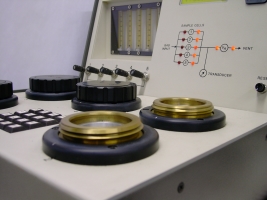Density analysis by helium pycnometry is used to obtain information on the true density or real density of solids. Since helium, which can enter even the smallest voids or pores, is used to measure the unknown volume of a material with a known weight, the final result is often referred to as skeletal density. By combination of the results of the helium pycnometry technique with bulk density or apparent density values derived from other techniques, such as mercury intrusion porosimetry, information on the porosity can additionally be obtained.
The helium pycnometry density measurements are performed on a Quantachrome or Anton Paar pycnometer which employs many different sample cell sizes. Accordingly, skeletal density analysis in a broad range of sample volumes, sample shapes and sample weights can be executed accurately. The use of a certified quartz reference material enables traceability of the measured helium density to NIST.
Besides skeletal density, our infrastructure also enables determination of tapped density, aerated density and untamped density as varieties of the bulk density and apparent density. These parameters are important descriptors to describe e.g. flow properties (flowability and floodability) of powders or loading of reactors.




